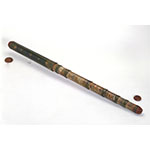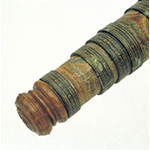Terrestrial telescope consisting of eight cardboard tubes. The largest is covered with green leather with gold tooling and contains the biconvex objective lens, 47 mm in diameter. The lens is signed by the maker (Giuseppe Campani) and inserted in a boxwood mount. The other tubes are covered with red marbled paper; some contain diaphragms. The eighth and smallest tube consists of two parts. The first is reversible. It contains two biconvex lenses and constitutes Campani's "compound spectacle"; the size and luminosity of the objects vary depending on which end of the housing is placed inside the tube. The second part contains a diaphragm and the sliding eyepiece, whose focal length is 58.4 mm. The instrument's magnification is 29 or 36, depending on the optical configuration. This is probably one of the 10-palm (2,230-mm) telescopes made by Campani in the mid-1660s; it is almost certainly the one he sent to Ferdinand II de' Medici in 1664.











